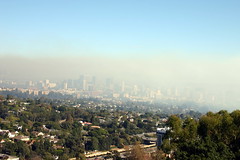 Image by oxyboricua via Flickr
Image by oxyboricua via Flickr
The Knock Against NOx by Derek Lang
Nitrogen Oxide is quite prevalent in the Earth's atmosphere. That said, the "noxious" mixture can be truly noxious as an active ingredient in smog (photochemical ozone) when it becomes a respiratory and eye irritant. NOx helps to form smog by reacting with VOCs (volatile organic compounds) in the presence of sunlight. NOx is primarily composed of NO and NO2, although most thermal NOx is NO.
Smog can be deadly. During smog "attacks" in Tokyo, Shanghai, and Los Angeles, hundreds of people have been killed due to the noxious mixture causing suffocation.
A winter temperature inversion caused the episode in Salt Lake City in 1976, which sickened many as well as providing a murky grayish-brown cast to a winter sky, which only a few miles away featured blue skies and uninhibited sunshine. Under the layer of smog in Utah's Salt Lake Valley, pollutants were trapped beneath a "lid" of sinking cold air as warmer air (which was layered in temperature inversions) struggled for ascendancy underneath. Cold air in the lowest layers near the surface completed an "atmospheric sandwich." The Utah situation was exacerbated by mountains surrounding the valley on three sides, which made clearing the stagnant atmosphere especially difficult to achieve. The 1976 event in Utah lasted for several months without interruptions.
Industrial emissions of NOx are easier to curtail. These can be either abated or controlled by primary measures of flue gas treatment technologies, such as burner optimization (excess air control, burner fine tuning), air staging (overfire air or two-stage combustion), flue gas recirculation, fuel staging (turning the burner off, fuel biasing, reburning, or three-stage combustion), and the implementation of low NOx burners.
Burner optimization techniques and low NOx burners are used to minimize the formation of NOx during combustion. In air staging and flue gas recirculation technologies, the aim is to reduce the oxygen availability to help reduce NOx formation and complete the combustion.
Derek Lang is with Epcon Industrial, a manufacturer of air pollution control systems, thermal oxidizers, and industrial gas fired ovens. Learn more at http://www.epconlp.com
![Reblog this post [with Zemanta]](http://img.zemanta.com/reblog_e.png?x-id=37a36c25-2b4f-4f37-8db9-b5702c44da8a)
No comments:
Post a Comment